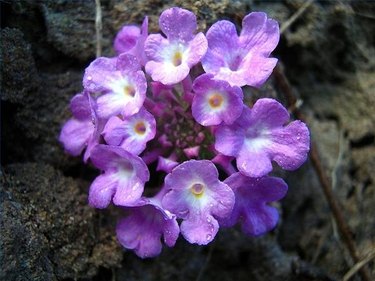Things You'll Need
Fertilizer
Secateurs or hand shears

Lantana montevidensis is a plant commonly known as trailing lantana, weeping lantana, creeping lantana, purple lantana or trailing shrub verbena. Native to South America, the tropical shrub has a trailing habit and is grown and propagated for use as an ornamental flowering perennial. It has small bright lavender-blue flowers and grows up to 24 inches in height with a reach of up to 5 feet. Lavender lantana blooms year-round in frost-free climates and is used as a low hedging, edging and ground cover and thrives in both sun and shade, but blooms more profusely in sunny locales. In climates where the plant tops die back, it begins blooming again in mid-summer. It is low-maintenance in care and feeding and requires pruning only to control shape and size as desired. It is hardy in USDA hardiness zones 8a through 11.
Step 1
Optimize soil conditions for your lantana.Till up the soil when planting to encourage quick root penetration into the soil. Plant lantantas at least 8 to 10 inches apart to allow them to spread and allow airflow, while still achieve a massing effect relatively quickly. Maintain a soil pH of between 5.6 to 7.8 and add pH soil amendments only when out of this optimal range.
Video of the Day
Step 2
Water in the lantana well so that the soil will always be moist when reaching an inch or two down. However, do not keep the water consistently wet.
Step 3
Fertilize lantanas twice a year with a good quality water-soluble fertilizer around the root ball at least 6 inches out from the main stem. Fertilize once in spring and again in summer. If it is a year-round plant in your climate, add a third feeding in fall.
Step 4
Prune lantana with secateurs or hand shears as needed to remove annual die off in the fall. Prune away damaged branches or vines and prune to control the shape and size to your liking. You can prune at any time of the year.
Warning
Lantana montevidensis is poisonous to livestock and should not be planted anywhere near where they might graze.
Video of the Day